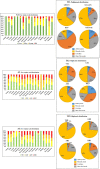An Endemic Plant of the Mediterranean Area: Phytochemical Characterization of Strawberry Tree (Arbutus unedo L.) Fruits Extracts at Different Ripening Stages
- PMID: 35782922
- PMCID: PMC9249387
- DOI: 10.3389/fnut.2022.915994
An Endemic Plant of the Mediterranean Area: Phytochemical Characterization of Strawberry Tree (Arbutus unedo L.) Fruits Extracts at Different Ripening Stages
Abstract
This work focused on the extraction, quantification, and characterization of bioactive compounds of Arbutus unedo L. fruits, comparing the results obtained from the different ripening states. Extractions were performed by different methods (such as maceration extraction and ultrasonic extraction) and food grade solvents (aqueous and hydroalcoholic solvents) in each of the all ripening states (four states considered, associated with four different colors, i.e., green, yellow, orange, and red). The presence of (poly)phenols was quantified and characterized, and scavenging activity was determined by the Folin-Ciocâlteu reagent and the DPPH method, respectively. The content of bioactive compounds was characterized by LC-MS/MS, such as multiple reaction monitoring (MRM) mass spectrometry. The results showed that ultrasound-assisted extraction (UAE) performed better than maceration extraction; ethanol-water mixture extracts showed a more positive effect than the use of aqueous extracts regarding the content of total phenolic compounds. Overall, the total phenolic compounds in the EtOH:H2O mixture at a ratio of 7:3 (v:v) were higher than that of the other solvents for both extraction methods. Some bioactive molecules were characterized for the first time in the extracts of A. unedo. The chemical profile of the strawberry tree extracts depended on the degree of fruit ripeness. The results suggest that A. unedo fruits may be of great interest for food and nutraceutical applications.
Keywords: Arbutus unedo L.; MRM mass spectrometry; radical scavenging activities; ripening process; total phenolic compounds.
Copyright © 2022 Scarano, Guida, Zuzolo, Tartaglia, Prigioniero, Postiglione, Pinto, Illiano, Amoresano, Schicchi, Geraci, Sciarrillo and Guarino.
Conflict of interest statement
The authors declare that the research was conducted in the absence of any commercial or financial relationships that could be construed as a potential conflict of interest.
Figures






Similar articles
-
Recovery of bioactive compounds from Arbutus unedo L. fruits: Comparative optimization study of maceration/microwave/ultrasound extraction techniques.Food Res Int. 2018 Jul;109:455-471. doi: 10.1016/j.foodres.2018.04.061. Epub 2018 Apr 30. Food Res Int. 2018. PMID: 29803472
-
Comparative Study on the Phenolic Fingerprint and Antioxidant Activity of Strawberry Tree (Arbutus unedo L.) Leaves and Fruits.Plants (Basel). 2021 Dec 22;11(1):25. doi: 10.3390/plants11010025. Plants (Basel). 2021. PMID: 35009028 Free PMC article.
-
Antityrosinase activity and LC-MS/MS analysis of optimized ultrasound-assisted condition extracts and fractions from strawberry tree (Arbutus unedo L.).J Food Drug Anal. 2024 Jun 15;32(2):194-212. doi: 10.38212/2224-6614.3496. J Food Drug Anal. 2024. PMID: 38934692 Free PMC article.
-
Arbutus unedo L.: From traditional medicine to potential uses in modern pharmacotherapy.J Ethnopharmacol. 2018 Oct 28;225:90-102. doi: 10.1016/j.jep.2018.07.004. Epub 2018 Jul 4. J Ethnopharmacol. 2018. PMID: 29981432 Review.
-
Use of Strawberry Tree (Arbutus unedo) as a Source of Functional Fractions with Biological Activities.Foods. 2022 Nov 28;11(23):3838. doi: 10.3390/foods11233838. Foods. 2022. PMID: 36496646 Free PMC article. Review.
Cited by
-
Next-Generation Sequencing (NGS) Identified Species-Specific SSR and SNP Markers, Allow the Unequivocal Identification of Strawberry Tree (Arbutus unedo L.) Germplasm Accessions and Contribute to Assess Their Genetic Relationships.Plants (Basel). 2023 Mar 31;12(7):1517. doi: 10.3390/plants12071517. Plants (Basel). 2023. PMID: 37050143 Free PMC article.
-
Vitis vinifera L. cv. Falanghina Seed Extracts: Antioxidant Effect of Bioactive Compounds on HepG2 Cells.Antioxidants (Basel). 2024 Jul 12;13(7):834. doi: 10.3390/antiox13070834. Antioxidants (Basel). 2024. PMID: 39061902 Free PMC article.
-
Development of a Pressurized Green Liquid Extraction Procedure to Recover Antioxidant Bioactive Compounds from Strawberry Tree Fruit (Arbutus unedo L.).Plants (Basel). 2023 May 17;12(10):2006. doi: 10.3390/plants12102006. Plants (Basel). 2023. PMID: 37653923 Free PMC article.
-
Sugar Content in Arbutus unedo L. Fruit and Its Relationship with Climatic and Edaphic Characteristics.Plants (Basel). 2024 Dec 1;13(23):3383. doi: 10.3390/plants13233383. Plants (Basel). 2024. PMID: 39683176 Free PMC article.
-
Strawberry Tree Fruit Residue as Carbon Source Towards Sustainable Fuel Biodesulfurization by Gordonia alkanivorans Strain 1B.Molecules. 2025 May 13;30(10):2137. doi: 10.3390/molecules30102137. Molecules. 2025. PMID: 40430310 Free PMC article.
References
-
- Torres JA, Valle F, Pinto C, García-Fuentes A, Salazar C, Cano E. Arbutus unedo L. communities in southern Iberian Peninsula mountains. Plant Ecol. (2002) 160:207–23. 10.1023/A:1015864821706 - DOI
-
- Gomes F, Canhoto JM. Micropropagation of strawberry tree (Arbutus unedo L.) from adult plants. Vitr Cell Dev Biol Plant. (2009) 45:72–82. 10.1007/s11627-008-9164-8 - DOI
-
- Takrouni MM, Ali IBEH, Messaoued C, Boussaid M. Genetic variability of Tunisian wild strawberry tree (Arbutus unedo L.) populations interfered from isozyme markers. Sci Hortic (Amsterdam). (2012) 146:92–8. 10.1016/j.scienta.2012.08.005 - DOI
-
- Soufleros EH, Mygdalia SA, Natskoulis P. Production process and characterization of the traditional Greek fruit distillate “koumaro” by aromatic and mineral composition. J Food Compos Anal. (2005) 18:699–716. 10.1016/j.jfca.2004.06.010 - DOI
LinkOut - more resources
Full Text Sources

